A Conversation Between: Jim Biddulph & Snehal Hannurkar
Proposing we build structures made from hemp and cork fabric would have raised more than a few eyebrows even as recently as a decade ago. But as the need to move away from carbon-heavy materials and processes has finally begun to sink in, the development of such biomaterials is becoming more pertinent than ever. Thankfully there are those with the required training and impetus to do so out there and working on projects like the BRIC Biobased Pavilion – as seen during last year’s Dutch Design Week.
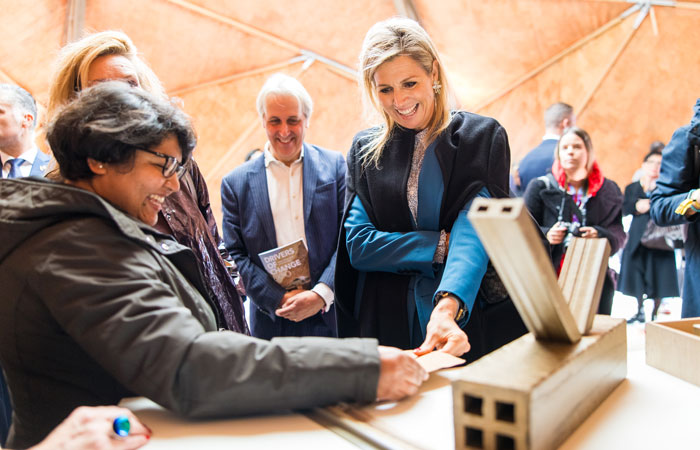
It’s a collaborative effort, led by Snehal Hannurkar, who alone has a The degree is Barchelors in Architectecture (B.Arch), a Post Graduate Dipolma in UN Urbanism from Bauhaus Dessau Foundation, as well as an Masters of Science (M.Sc) in Architecture Building and Planning. and an Engineering Doctorate (Eng.D) in Biobased Constructions (2023) from TU/e Eindhoven university of technology, The Netherlands. Having worked as researcher and urbanist on developing green and sustainable urban strategies for post-war cities of Mostar in Bosnia Herzegovina and Kabul in Afghanistan, she co-founded Studio13 in Goa, India, back in 2007. The move to Eindhoven was largely triggered by a desire to switch to more sustainable and circular design strategies, and it was during her Doctorate studies that she began work on the material experiments that led to the 80-90-person capacity pavilion. Having explored the space in Holland I wanted to find out more from Snehal about how it came about and what exciting things might come next.
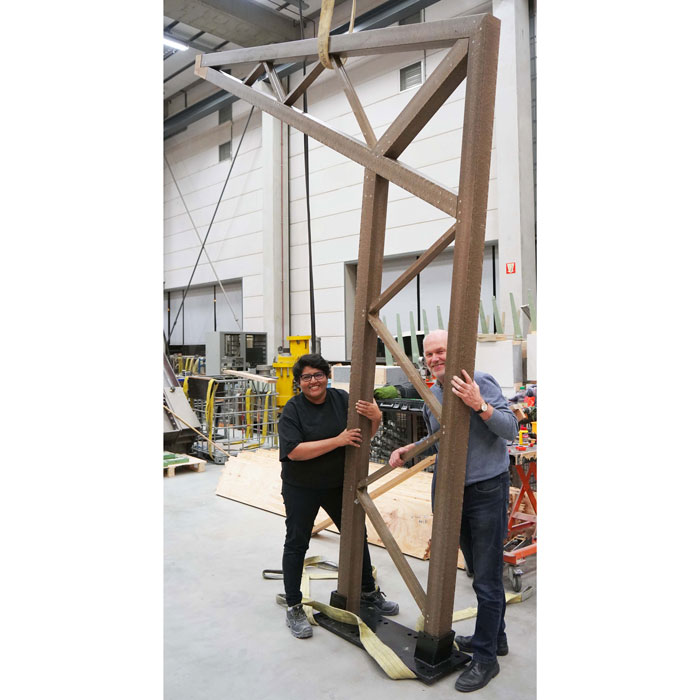
JB: Where and when did your interest in biomaterials begin – was there a specific project or other form of catalyst? And why bio-based over other more traditional materials?
SH: In 2015, I participated in a Bamboo construction workshop held at the Green Village in Bali, Indonesia. It was an eye-opener! I realised the potential of biobased; the beauty and strength they can bring in the buildings with a much smaller carbon footprint than conventional construction materials do. I was awestruck by the multi-storeyed structures built in the Green Village using only bamboo. It awakened a consciousness within me to design responsibly and boosted my interest in using biomaterials for construction.
Compared to contemporary construction materials, biomaterials are more environmentally friendly and circular. Conventionally used materials like concrete and steel have immense strength but at the same time, they have large carbon footprints which affect the environment deeply and negatively. The indoor spaces created using these materials are also questionable considering health standards for inhabitants as compared to the spaces created using Biomaterials. Hence, I am more keen to advocate for the use of biomaterials.
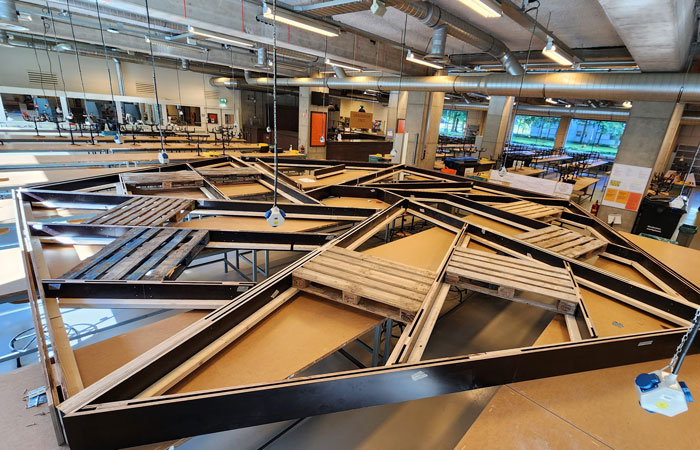
JB: The BRIC Biobased Pavilion caught my eye from afar during Dutch Design Week last year, and didn’t disappoint on closer inspection. I was thrilled to see biomaterials being used at such a scale and would love to know more about how and why the project came about.
SH: I am very pleased to hear of the impression BRIC Biobased Pavilion has left on you, that feels like a mission accomplished. Firstly, BRIC is a consortium of 9 partners led by the Department of Built Environment, TU/e Eindhoven University of Technology, and the pavilion was an OPZuid project, which are grants intended to support SME’s (small and medium enterprises). As a part of my Engineering Doctorate at the university, I was hired as the lead architect and researcher to design a pavilion using biobased composite profiles developed by Millvision B.V, a company that specialises in such materials. Throughout the project, I was mentored by Dr. Faas Moonen and Ir. Tom Veeger, who were very supportive and actively participated in the building process.
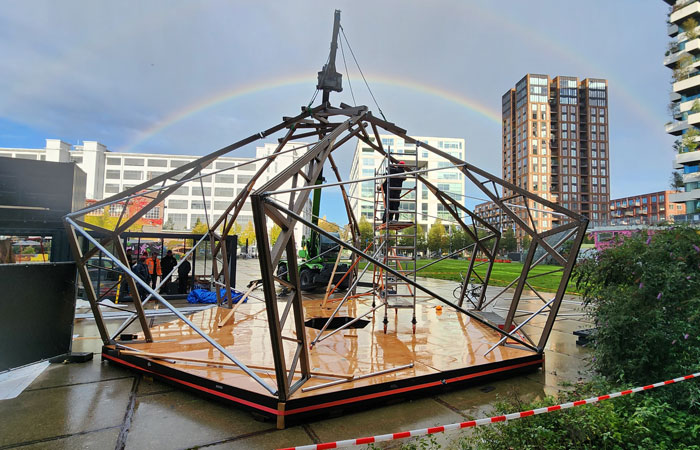
The challenge for me was to design and build an enclosable space, using these biobased composite profiles as structural elements and exploring their scalability in terms of their strength, size, and aesthetics. These composite profiles are made from a mixture of flax, hemp fibres, waste wood, and tomato stems using a method of extrusion. More specific information about the manufacturing of these profiles can be found on the pavilion website.
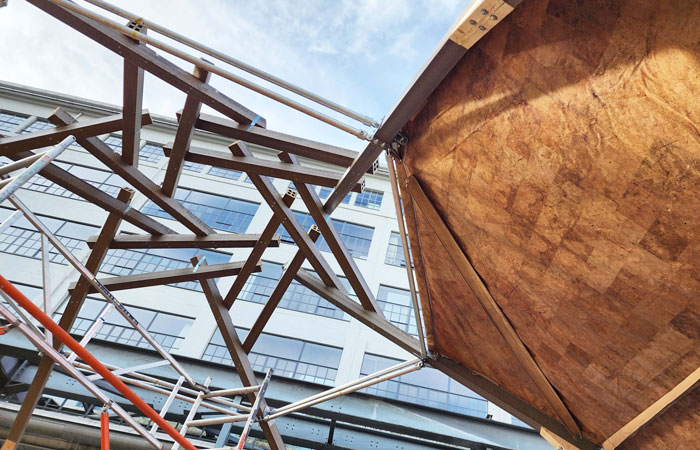
JB: Discovering that such bio-based materials had been extruded like that was particularly exciting to see, and the design itself really showcased how they might be used structurally. Can you tell me a little more about what you’ve discovered from working with them in this way?
SH: Throughout my Eng. Doctorate, I developed various architectural designs based on different structural systems that focused on using the Millvision biobased composite profiles for the structure in combination with biomaterials like cork and flax fabric, which acted as a skin. These designs were structurally assessed by a separate team of two, led by Dr. Faas Moonen. Based on these assessments I further developed true-scale prototypes of the structural truss frame made from the Millvision biobased profiles along with two of my colleagues and mentors. This structural frame was first exhibited in Dutch Design Week 2022, and the final building was later exhibited at the Dutch Design Week 2023. The entire structure of the pavilion, which includes the column trusses, floor beams, and the reciprocal roof was built in the laboratory of the Department of Built Environment and proves that biomaterials can most definitely be used in construction.
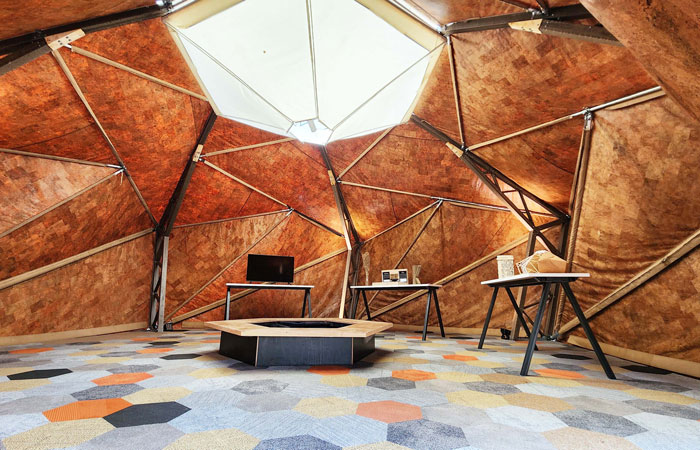
JB: Can you explain the design itself in more detail too – how does the structure work and how do the separate elements come together?
SH: The BRIC pavilion is designed for disassembly. It consists of four main components; the floor, the columns, the reciprocal roof, and the envelope. The column truss and the reciprocal roof are designed using Millvision biobased composite profiles. The floor is made from pallets that are removable and reusable, and they are supported by dismantlable beams made from multiplex. This assembly is topped off with reusable and recycled tiles. The floor is designed in the shape of a hexagon and the six-column trusses are located at each corner of the hexagonal floor at an angle to create a twisted form. The column frames are connected at the top ends with aluminum beams.
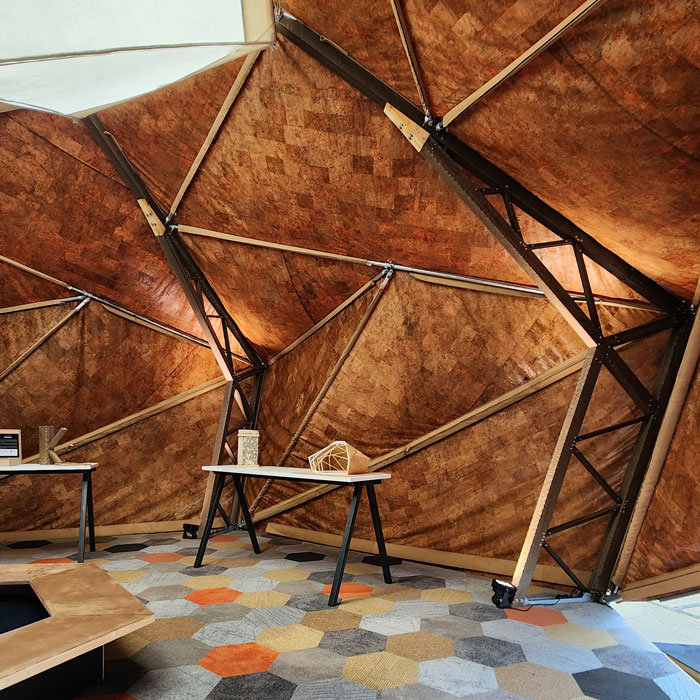
The reciprocal roof is also hexagonal in plan and rests on this assembly of column trusses. The envelope is made from cork fabric and is stitched in the shape of the volume created by the structure in six identical parts. These are draped down over the structure and connected to the structural frame with zippers for easy set-up and unfastening. The entire structure can be assembled in a day and taken apart in even lesser time. Each column weighs around 100 kilos and the reciprocal roof weighs around 300 kilos. The cork fabric is deliberately lightweight in comparison to the structure itself but is strong enough to take moderate wind and rain. Its performance was tried and tested most vigorously during Dutch Design Week back in October 2024!
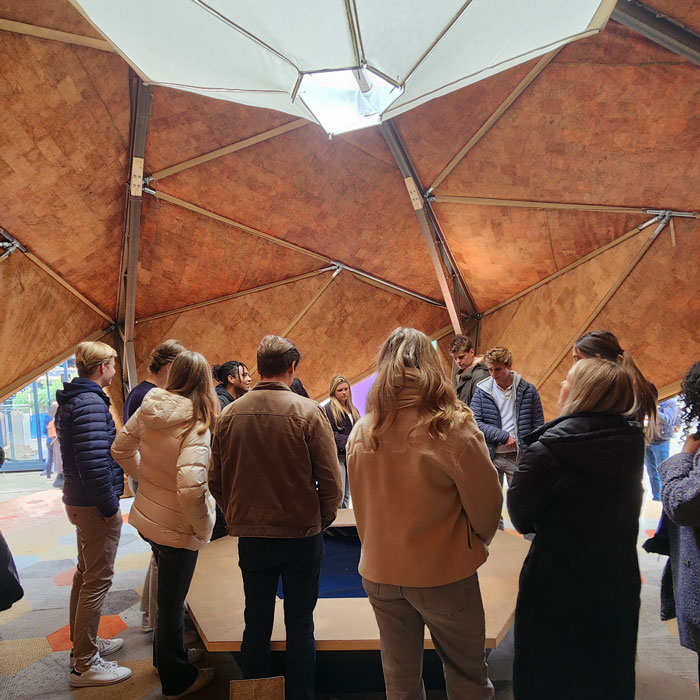
JB: There’s been a gradual rise in the awareness and desire for biomaterials in the built environment but scaling up is always a challenge. What do you think are the next steps and perhaps things to overcome?
SH: Conventional materials like steel, concrete and plastic have set a very high standard in the market in terms of strength, durability, and ease of construction. These biobased composites and other biomaterials must be developed to match a level where they can be widely accepted while competing with these standards, which is a huge challenge. There are still a number of things that need to be achieved, including having readily available raw materials for scaling up, ease of workability and application, improvement in the strength of the material for a variety of applications, durability in various climatic conditions, end-of-life analysis and standardising the recycling process. But we’ve now taken the first big steps.
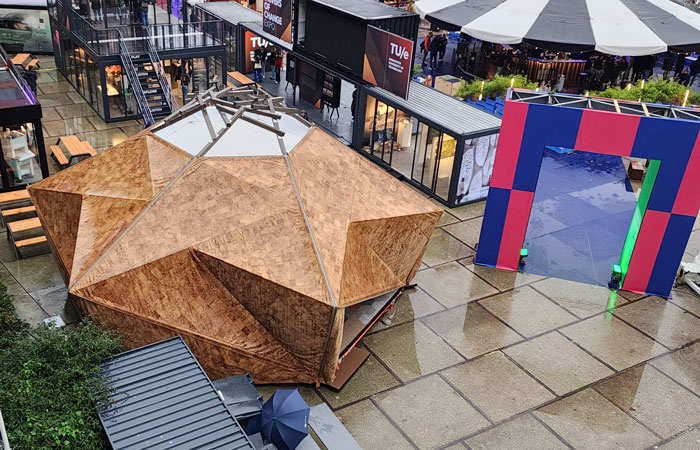
More research and development is needed, which requires collaboration between educational institutions, funding organisations, and the construction industry. Together we can propose more projects like the BRIC pavilion, and dive even deeper into reaching the optimum potential of the biomaterials. I’m hopeful with more exhibitions and events we can continue to achieve the goal of making biomaterials widely accepted in the market. And we should because one of the biggest advantages of biobased composites is that they can be completely recycled into their original form of profiles. So I’m positive that they can substitute materials with a high carbon footprint in temporary structures meant for festivals and events in the near future.
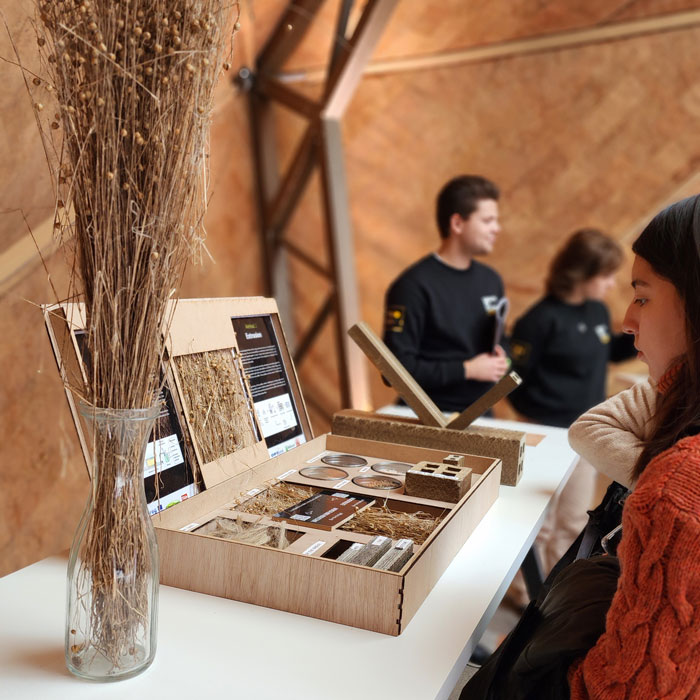
JB: And are there any other developments or new projects in the pipeline that you’re able to share right now?
SH: Yes! I founded a start-up RE-form Gypxel almost a year ago. Reform fosters collaborative thinking to reinvent the value of materials of waste streams into useable circular products, through innovative and circular design and manufacturing strategies.
Using waste gypsum, sheep wool, and recycled fabric, I designed and developed circular acoustic tiles for the municipality of Nissewaard in the Netherlands, hence REform will soon introduce its first product- Gypxel circular acoustic tiles.
This pilot project is a collaboration between Reform Gypxel, Municipality of Nissewaard, Reinis (waste collection company), and Voorne Putten Werkt (a social atelier). The tiles are currently in production and the launch of the first batch will take place soon (we’re aiming for July) and will be displayed at the Municipality of Nissewaard.




